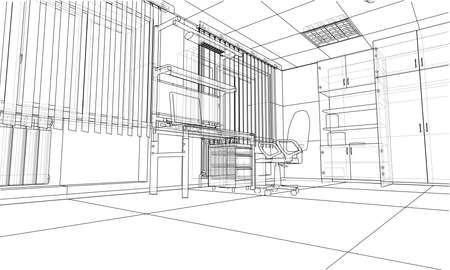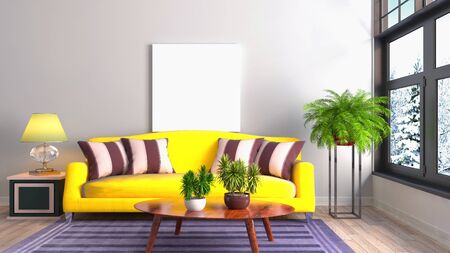Introduction to Feature Walls in British Homes
In the ever-evolving landscape of UK interior design, feature walls have carved out a distinctive niche as both a visual anchor and a creative statement within British homes. These striking wall treatments offer more than just a splash of colour; they redefine room dynamics, influence spatial perception, and provide homeowners with an accessible way to inject personality into their living spaces. Across townhouses in London to cosy cottages in the Cotswolds, feature walls are celebrated for their ability to transform ordinary rooms into captivating environments without overwhelming the overall décor. Their popularity lies in the British penchant for understated elegance paired with bold accents—a harmonious blend that allows individuality to shine while respecting traditional aesthetics. Whether through paint, wallpaper, or textured finishes, feature walls serve as an artistic focal point, drawing the eye and setting the tone for the rest of the room. As British homeowners continue to seek fresh approaches to space enhancement, mastering the art of feature wall painting has become an essential skill for those looking to elevate their interiors while embracing personal style and local charm.
2. Choosing the Perfect Wall and Colour Palette
Creating a feature wall is about more than just a splash of paint—it’s about elevating your space with intention and artistry. Selecting the right wall is key for maximum visual impact. Typically, the ideal wall will be the room’s natural focal point: perhaps behind the headboard in a bedroom, framing a fireplace in a lounge, or anchoring the dining area. Avoid walls interrupted by doors or excessive windows, as these can diminish the dramatic effect.
Guidelines for Selecting Your Feature Wall
| Room Type | Ideal Feature Wall Location | Why It Works |
|---|---|---|
| Lounge/Sitting Room | Fireplace wall or TV backdrop | Draws attention to central social areas |
| Bedroom | Behind the bed’s headboard | Creates an elegant focal point for relaxation |
| Dining Room | Main uninterrupted wall | Adds sophistication to entertaining spaces |
| Hallway/Entrance | The first visible solid wall upon entry | Makes a memorable first impression |
Selecting Colours that Suit British Homes
The British aesthetic elegantly balances tradition and modernity. When choosing your colour palette, consider both your existing décor and the mood you wish to evoke. For period homes, heritage tones like deep navy, moss green, or rich burgundy pair beautifully with original features. In contemporary settings, opt for muted greys, sage greens, or dusky pinks to maintain a fresh yet sophisticated vibe. Always test swatches in natural daylight and observe how the hues shift throughout the day—a subtle nod to Britain’s famously changeable weather.
Tips for Harmonising Your Feature Wall with British Décor:
- Coordinate, don’t match: Choose shades that complement your furnishings and architectural details rather than copying them exactly.
- Consider undertones: Cool tones work well in rooms with ample natural light; warmer hues add cosiness to north-facing or shadowy spaces.
- Add texture: Paint finishes such as matte, eggshell, or even textured wallpaper can enhance depth and character.
- Edit your accents: Once painted, select cushions, throws, or artwork in complementary shades to tie the scheme together.
Your feature wall should not only catch the eye but also feel entirely at home within your British interior—timeless yet tailored, striking yet harmonious.

3. Essential Prep: Tools and Surface Preparation
Before you lift a brush, setting the stage for a flawless feature wall is crucial. Achieving that coveted British-standard finish requires more than just enthusiasm; it’s all about having the right kit and nailing the prep work. Here’s how to get started:
Must-Have Painting Tools
- Quality Paint Brushes and Rollers: Opt for British-made brushes with synthetic bristles for smooth application, and select rollers suitable for your wall texture.
- Painters’ Tape: Essential for those crisp, clean lines—especially around skirting boards and sockets.
- Dust Sheets or Canvas Drop Cloths: Protects floors and furnishings from splatters.
- Sanding Block or Fine-Grit Sandpaper: Ensures your surface is as smooth as a freshly brewed cuppa.
- Filler and Putty Knife: For patching up any holes or hairline cracks typical in period homes.
- Spirit Level and Pencil: To mark out geometric or panelled designs with precision.
Step-by-Step Surface Preparation
- Clear the Area: Move furniture away from the wall and cover everything with dust sheets. Good prep means fewer regrets later.
- Clean Thoroughly: Wash down your wall using mild soap and warm water to banish dust, grease, or old cobwebs—no shortcuts here!
- Smooth It Out: Fill any dents, cracks, or nail holes with quality filler. Once dry, sand gently until your wall feels seamless under your fingertips.
- Tape Up: Apply painters’ tape along edges, sockets, and trims. Press firmly to prevent paint bleed—a hallmark of a well-executed British feature wall.
- Prime (If Needed): For bold colours or newly plastered surfaces, a good primer ensures even coverage and true-to-tin colour results.
British Finishing Touches
A well-prepped wall not only looks professional but stands up to the test of time—think of it as giving your space the royal treatment. Take your time with these steps; after all, every iconic British interior begins with meticulous groundwork.
4. Painting Techniques: From Statement Stripes to Subtle Ombre
When it comes to feature walls, the right painting technique can transform a space, infusing personality while complementing quintessential British interiors. Here’s a breakdown of popular DIY techniques that suit everything from Victorian terraces to modern flats across the UK.
Bold Geometric Patterns
Geometric patterns have surged in popularity, especially in urban homes looking for a contemporary twist. Using painter’s tape and a steady hand, you can create everything from chevrons to diamond grids. These shapes add structure and visual intrigue, particularly effective in living rooms or hallways where you want to make a statement without overpowering the rest of the décor.
How to Achieve Geometric Perfection
| Technique | Materials Needed | Best Room Placement |
|---|---|---|
| Classic Chevron | Painters tape, spirit level, two contrasting paint colours | Lounge feature wall or dining room alcove |
| Diamond Grid | Tape measure, masking tape, small roller brush, metallic accent paint | Entrance hallway or home office backdrop |
Statement Stripes: Vertical and Horizontal
Stripes offer timeless appeal, especially when tailored with heritage-inspired hues such as deep navy or muted sage. Vertical stripes can elongate walls—a trick beloved in period properties with low ceilings—while horizontal stripes widen compact London flats. Always use quality masking tape for crisp edges and remember to keep your lines even with a reliable spirit level.
Tips for Flawless Stripes
- Select two or three harmonious shades for subtlety or bold contrast for drama.
- Measure twice and mark lines lightly with pencil before taping.
Soft Colour Transitions: Ombre Walls
The ombre technique delivers gentle gradations that evoke misty British mornings or coastal sunsets along Cornwall. This method requires blending two or more tones seamlessly, usually moving from darker at skirting boards to lighter near the ceiling for an airy effect. It works beautifully in bedrooms, nurseries, or reading nooks where tranquillity is key.
Step-by-Step Ombre Guide
- Choose your palette—classic combinations include stone greys fading into white or blush pinks merging with soft taupe.
- Apply the darkest shade at the base using a roller.
- Add mid-tones above, blending gently with a damp sponge where the colours meet.
- Finish with the lightest colour at the top, feathering transitions until smooth.
No matter your choice of technique, thoughtful planning and patience are essential for a striking feature wall that feels at home in any British setting—whether you’re aiming for bold impact or understated elegance.
5. Styling Your Space Around a Feature Wall
With your striking feature wall complete, the next step is to thoughtfully style your space so that every element feels cohesive and inviting. Interior design is as much about balance as it is about bold statements. Here’s how you can harmoniously complement your new focal point with furniture, soft furnishings, and those delightful British touches that bring character to any home.
Choosing the Right Furniture
Select pieces that won’t overshadow your feature wall but rather enhance it. Opt for classic silhouettes—a Chesterfield sofa or a mid-century sideboard—finished in neutral tones such as dove grey, oatmeal, or gentle sage. Position larger items away from the wall to allow its artistry to breathe; consider glass-topped tables or open shelving for an airy, uninterrupted view of your handiwork.
Layering Soft Furnishings
Textiles are key to softening bold colours or patterns. Introduce quintessentially British fabrics such as tweed cushions, velvet throws, or woollen rugs in complementary hues. If your feature wall boasts deep emerald or navy, layer in blush pinks or muted golds for warmth and depth. For patterned walls, stick to subtle textures and solids to avoid visual clutter.
Adding British Accents
No British-inspired room is complete without charming details: think antique brass lamps, framed botanical prints, or a vintage tea set displayed on a console. Incorporate heritage motifs—perhaps a Union Jack cushion or tartan footstool—for a playful nod without overwhelming the room. Houseplants like English ivy or potted lavender add freshness and a touch of countryside calm.
Finishing Touches
Balance contemporary lines with traditional craftsmanship: oak flooring, cornicing, or even a Victorian-style fireplace can anchor the space. Use mirrors with ornate frames to reflect your feature wall’s beauty and amplify natural light—a trick beloved in London terraces and country cottages alike.
Ultimately, successful styling ensures your feature wall takes centre stage while every detail feels intentional. Embrace the layered elegance of British interiors by blending statement-making artistry with comfort and timelessness—your newly transformed space will be both inspiring and unmistakably home.
6. Troubleshooting & Maintenance
Common DIY Mishaps: Quick Fixes
No matter how careful you are, a few slip-ups are all part of the DIY journey. For paint drips or runs, allow the area to dry fully before gently sanding it back and touching up with a small brush. If you spot uneven coverage or streaks, apply a thin, even second coat once the first layer is completely dry. For those stubborn roller marks or brush strokes, lightly sand the area and reapply paint using a high-quality roller for a smoother finish.
Addressing Peeling and Bubbling
The UK’s ever-changing climate—think chilly winters and damp summers—can sometimes cause paint to peel or bubble. This usually happens when moisture gets trapped under the paint layer. To remedy this, scrape away the affected section, let the wall dry thoroughly, then prime and repaint using moisture-resistant paints that suit British weather conditions.
Dealing with Mould and Mildew
Especially in older British homes or north-facing rooms, mould can crop up on feature walls. Clean any affected areas with a mild bleach solution (always test in an inconspicuous spot first), allow to dry, and repaint using anti-mould paints for added protection against the damp.
Maintaining Your Feature Wall’s Fresh Appeal
To keep your statement wall looking sharp year-round, gently dust it with a soft cloth or feather duster every few weeks. For stubborn marks—perhaps from little ones’ hands or pets—a slightly damp sponge should do the trick, but avoid harsh chemicals that may dull the colour or finish.
Protecting Against Fading
Sunlight in south-facing rooms can lead to fading over time. Consider using curtains or blinds during peak hours or choose UV-resistant paints designed for brighter spaces. Repainting every few years will also help maintain vibrancy.
Your Wall, Your Canvas
A well-cared-for feature wall not only transforms your living space but stands as a testament to your creativity and care. With these troubleshooting tips and maintenance routines tailored for UK homes, your masterpiece will remain a focal point—rain or shine.


